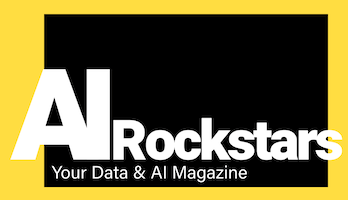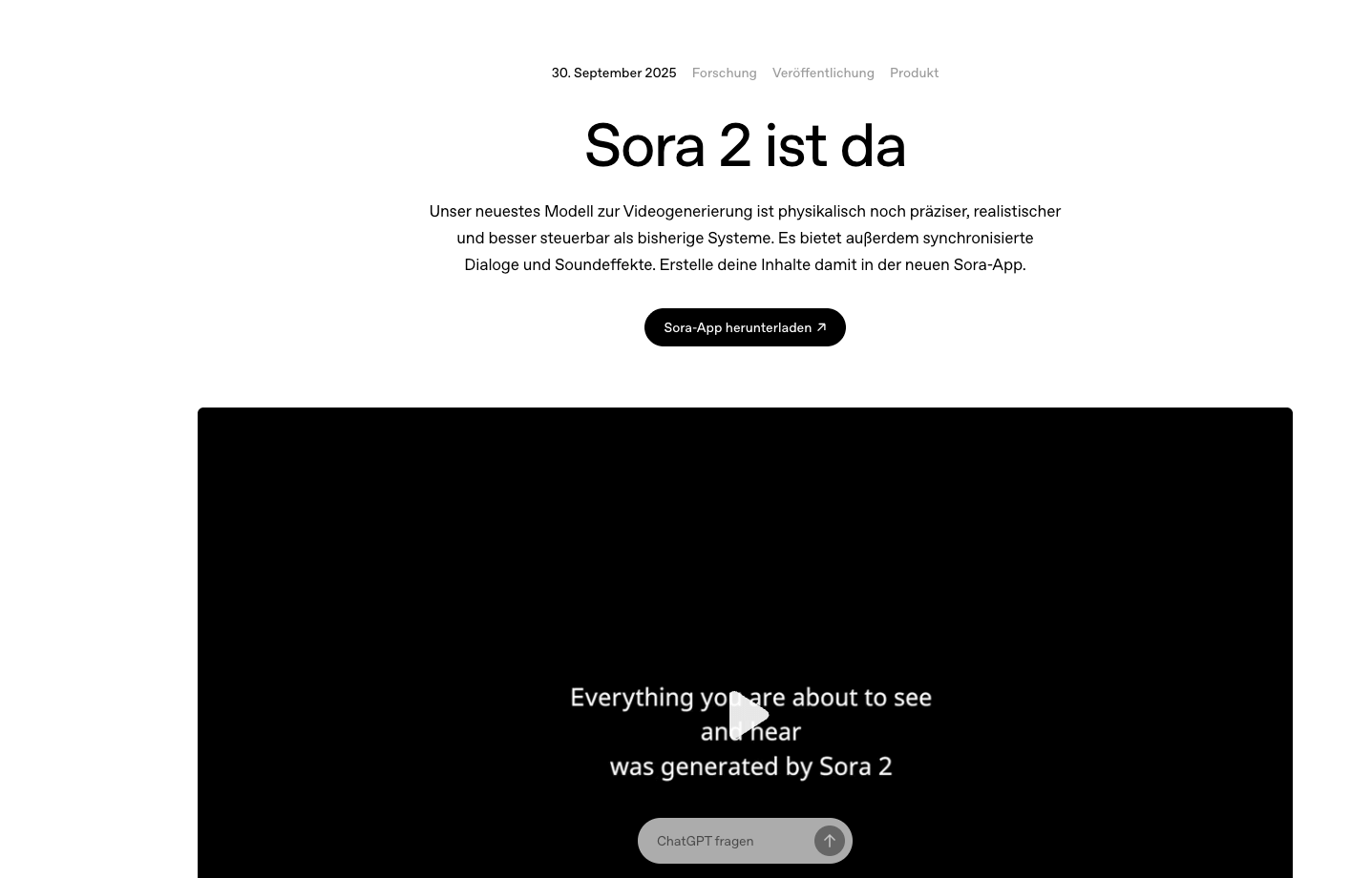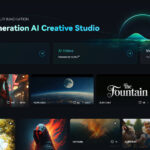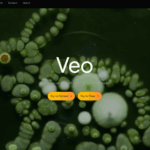Sora 2 revolutionizes AI video generation with hyper-realistic videos with synchronized audio and drastically reduced production effort. The following points show what makes the tool so groundbreaking and what you should pay attention to when using it.
- Three core functions set Sora 2 apart from competing products: The perfect physics simulation without typical AI artifacts, the automatic audio synchronization with lip movements and the unique cameo feature for integrating real people into generated scenes.
- The cost efficiency is impressive – instead of 15,000 to 25,000 euros for traditional video productions, Sora 2 only incurs API fees of around 500 to 800 euros, while production time is reduced from weeks to days.
- Legal risks require strict precautions, especially when portraying people. You need explicit declarations of consent for each person depicted and must transparently label AI-generated content.
- Technical limitations restrict immediate applicability – the lack of video-to-video editing, the blocking of public-figure content and the enormous computing effort currently make the tool more suitable for experimental projects than for business-critical campaigns.
- Effective prompts are crucial for optimal results. Use precise instructions such as “A 45-year-old CEO in a modern office explains software features” rather than vague descriptions to get the desired visual styles and scenarios.
Despite current limitations, Sora 2 offers revolutionary possibilities for marketing teams willing to break new ground in video production and familiarize themselves with the legal framework.
Imagine controlling your entire video marketing by text command – realistic scenes, perfectly synchronized sound and your team as protagonists, all in minutes instead of days. Sounds like sci-fi? Sora 2 from OpenAI makes exactly that a reality. 🚀
Why is Sora 2 playing such a big role for marketing leads, product developers and creators right now? Because it turns the effort, cost and complexity of traditional video production on its head. Hyper-realistic moves, integrated audio and real people as digital cameos – no other AI tool is currently getting more output out of so little input.
You want to know:
- What makes Sora 2 tick and what really makes it better
- What opportunities and pitfalls the features bring
- How you can practically integrate Sora 2 into your workflows today – legally compliant and transparent
We’ll take you on a deep dive – from physically correct actions to compliance checklists. With copy & paste prompts, mini FAQs and practical tips instead of buzzword bingo.
If fast content production, brand-boosting videos and real time savings appeal to you, you should read on.
In the next section, you’ll find out how Sora 2 is already rewriting the rules for digital brand communication and product development with concrete examples.
What is Sora 2 and why is it a game changer?
Sora 2 marks a turning point in AI video creation – for the first time, hyper-realistic videos with perfectly synchronized audio are created from simple text descriptions. OpenAI’s latest model revolutionizes content production through a combination of physically correct rendering and natural audio integration.
OpenAI’s latest leap in AI video generation
While Sora 1 already generated impressive video clips, Sora 2 takes realistic physics simulation to a new level. Complex gymnastic exercises, falling objects or flowing movements look authentic – without the typical AI artifacts such as morphing or teleportation.
The decisive difference to tools such as Runway or Pika Labs: automatic audio synchronization. While other platforms require separate audio processing, Sora 2 delivers complete audiovisual experiences with background sounds, dialogues and lip synchronization.
The revolutionary Cameo feature
The groundbreaking innovation is the realistic integration of real people into generated scenes. After a short video recording, you or your team can appear authentically in any desired environment – with full control over appearance and voice.
The most important improvements at a glance
- Precise physics engine: Natural movement sequences without typical AI errors
- Integrated audio generation: Contextual sounds and perfect lip synchronization
- Advanced style control: From photorealistic to anime aesthetics
- Consistent object representation: Stable characters over longer video sequences
💡 Tip: The invite-only availability currently makes Sora 2 the exclusive solution for premium content strategies.
Sora 2 transforms elaborate video production into text commands in minutes – a real paradigm shift for marketing teams, creators and companies that need high-quality video content without traditional production costs.
The core features of Sora 2 in detail
Sora 2 sets new standards in AI video generation with three groundbreaking features that will fundamentally change traditional video production.
Enhanced fidelity and physics accuracy
OpenAI has reworked the physics simulation from the ground up. Sora 2 masters complex movements such as gymnastics or falling objects faithfully, without the typical AI weaknesses of its predecessors.
The most important improvements at a glance:
- Object persistence: objects no longer suddenly disappear or change shape
- Motion logic: Realistic representation of gravity, inertia and collisions
- Continuity: Consistent presentation over longer video sequences
Audio integration as a unique selling point
The synchronized audio makes Sora 2 fundamentally different from competing products such as Runway or Pika Labs. The AI not only generates suitable background noises, but also automatically synchronizes lip movements with spoken text.
These functions make separate audio tools superfluous:
- Lip synchronization: perfect coordination between mouth movements and speech
- Contextual sound effects: Automatic generation of ambient sounds
- Dialogue generation: Natural-sounding voices for different characters
The cameo feature: opportunities and challenges
The cameo function enables the hyper-realistic integration of real people into generated scenes. After a short video recording, you can portray yourself or others in any context.
Important aspects for practical use:
- Declaration of consent: Explicit consent required from all persons depicted
- Voice control: Complete control over appearance and voice output
- Legal limits: No depiction of public figures without their permission
These three core features make Sora 2 the most advanced AI video generation tool currently available and open up completely new possibilities for content creators and companies.
In practice: Where Sora 2 creates real added value
Sora 2 transforms complex video productions into tasks in a matter of minutes – from personalized advertising campaigns to interactive learning materials. The technology is particularly suitable where traditional video production would be too expensive or time-consuming.
Content creation and marketing
A/B testing becomes a cost-effective routine with Sora 2: instead of one expensive production, ten different advertising versions for different target groups are created in just a few minutes.
Product demonstrations can be created without complex sets – the Cameo feature enables business managers to present their products in a wide variety of environments:
- Personalized videos for specific customer segments
- Social media content with synchronized audio
- Product presentations without physical prototypes
Entertainment and media production
Filmmakers use Sora 2 as a cost-effective storyboarding tool: Complete scenes are visualized and tested before the actual production.
Pre-production costs are drastically reduced as animations and concepts can be checked immediately. Advertising agencies create rapid prototyping for customer presentations without risking expensive shooting days.
Education and training
Interactive educational videos benefit from controllable physics simulations: Complex scientific processes are presented in a visually comprehensible way.
Scenario-based training materials are created for various industries – from safety training to sales training with realistic customer dialogs.
API integration for developers
The Sora 2 API enables seamless integration into existing content management systems. Agencies automate complete video workflows, while SaaS platforms offer scalable content production.
Developers can extend third-party apps with video generation and thus open up completely new business models.
The greatest efficiency gains are achieved by companies that produce recurring video content – from product updates to personalized customer communication.
Risks and legal pitfalls
Sora 2’s hyper-realistic video generation comes with significant legal risks that companies need to be aware of and mitigate immediately. The cameo function and perfect physics simulation create new areas of liability that go far beyond previous AI tools.
Deepfake problem and potential for abuse
The non-consensual use of personal rights is at the center of legal concerns. OpenAI’s moderation system makes it possible to block public-figure deepfakes, but private individuals remain vulnerable.
These applications are particularly problematic:
- Impersonation in business contexts: False CEO statements or product recommendations
- Fraudulent advertising: Celebrities “advertise” questionable products without consent
- Disinformation: Hyper-realistic news reports or political statements
Legal situation in Germany: What companies need to be aware of
German companies have to comply with several areas of law at the same time. The Art Copyright Act under Section 22 KUG requires explicit consent for every depiction of a person – including AI-generated videos.
The central compliance requirements include:
- Labelling obligation: AI-generated content must be recognizable as such
- GDPR compliance: especially for biometric data for cameo features
- Imprint obligation: Also for automatically generated advertising content
- Liability: Companies are liable for legal violations caused by their AI content
Increased risks for minors
OpenAI implements increased moderation thresholds for content involving children and young people. Nevertheless, legal gray areas remain, as German youth protection laws are stricter than US standards.
The main risk areas relate to age verification during use, parental controls for underage performers and stricter deletion obligations for problematic content.
Companies should develop internal compliance guidelines before using Sora 2 productively. The legal consequences of violations can be life-threatening – from warnings to criminal investigations.
Security measures and prevention strategies
OpenAI has implemented multi-layered security measures in Sora 2 from the outset to prevent misuse and ensure responsible use.
OpenAI’s multi-level moderation system
The automated filtering system checks every step of content creation in real time. The AI analyzes your text input before a video can even be created.
During creation, all generated frames and audio tracks are continuously scanned for problematic content. The system automatically recognizes violent scenes, explicit depictions or non-consensual depictions of personality.
The invite-only rollout initially restricts access to selected users and companies. OpenAI categorically prohibits the creation of public-figure deepfakes – well-known personalities cannot be depicted without explicit consent.
Technical protective measures
Provenance tools and watermarks are automatically embedded in every generated video. These invisible markings make it possible to clearly identify Sora 2 content at a later date.
Reported or suspicious content undergoes a human review process. Trained moderators evaluate problematic videos within 24 hours and adjust the filter criteria accordingly.
The safety guidelines are continuously updated based on new abuse patterns and community feedback.
Best practices for users
Obtain explicit consent before featuring people in your videos – even with the Cameo feature. Transparently label all AI-generated content as such, especially for commercial use.
Develop internal compliance guidelines for your team that clearly define legal boundaries and ethical standards.
💡 Tip: Document all declarations of consent in writing and keep screenshots of the prompts used – this will protect you in the event of legal issues later on.
These preventative measures create the basis for responsible AI video use without disproportionately restricting creative possibilities.
Boundaries and current limitations
Despite its impressive progress, Sora 2 comes with significant limitations that you should consider when planning your projects.
Technical limitations
Video-to-video generation is completelymissing at launch. So you can’t take existing video footage and have Sora 2 modify it – only text-to-video creation is possible.
The blocking of public-figure content prevents the creation of videos with well-known personalities, politicians or celebrities. This restriction also applies to the Cameo feature, which eliminates numerous commercial applications.
In complex physics scenarios, Sora 2 still shows weaknesses in edge cases. Especially with:
- Rapid changes of direction of objects
- Complex fluid simulations
- Multiple simultaneous motion sequences
Practical challenges
The enormous computing effort leads to long waiting times and limited availability. OpenAI has restricted its use to an invite-only system, which makes spontaneous projects impossible.
The staggered introduction means: no scalability for larger campaigns or continuous content production. Teams have to calculate with unpredictable capacities.
💡 Tip: Plan buffer times of at least two to three weeks for Sora 2 projects and always develop a backup strategy with conventional video tools.
The complete dependence on OpenAI’s infrastructure makes you vulnerable to outages, changes in terms of use or price adjustments.
For most marketing teams, this means that Sora 2 is currently more suitable for experimental projects than for business-critical campaigns with fixed deadlines.
Practical example: Video marketing campaign with Sora 2
A medium-sized software company creates a complete marketing campaign with Sora 2 – without an external production team and with 90 percent less budget than with conventional video production.
Step-by-step guide
Concept development starts with structured prompts that define specific scenarios. Instead of vague descriptions, you use precise instructions: “A 45-year-old managing director in a modern office explains software features while the dashboard runs on a monitor in the background.”
Cameo integration enables authentic personality despite AI generation. The managing director records a one-minute video that Sora 2 uses as a reference for facial features and voice. The AI then generates various scenarios – from customer meetings to product demos.
Variation and A/B testing of different styles
Sora 2 creates multiple versions in different visual styles from a basic concept:
- Photorealistic office environment for B2B target groups
- Animated explanatory style variant for social media
- Cinematic version with dramatic lighting for trade fairs
💡 Tip: Copy & paste prompts for typical use cases
Product presentation template:
“Show a professional person operating [product name] while a split screen view shows the software interface and real results simultaneously, duration 30 seconds”
Explainer video structure:
“Create a step-by-step sequence with animated arrows and highlights that breaks down a complex process into three simple stages”
Cost analysis and ROI consideration
Traditional video production for five campaign variants costs between 15,000 and 25,000 euros plus two to three weeks of production time. With Sora 2, the costs are reduced to approx. 500 to 800 euros API fees with two days development time.
The automatically generated lip synchronization and contextual audio effects completely eliminate separate audio post-production.
The result: five high-quality campaign videos with personalized messages for different target groups that achieve 40 percent higher conversion rates in A/B tests than static content – at a fraction of the traditional production costs.
Conclusion
Sora 2 is a game changer for anyone who needs high-quality video but doesn’t have the budget of traditional production teams. The combination of hyper-realistic presentation and automatic audio synchronization makes complex content strategies feasible for companies of all sizes.
The technology is there – now it’s all about intelligent implementation despite current limitations.
The most important fields of action for you:
- Experiment with invite-only access and test different prompt structures for your industry
- Develop internal compliance guidelines before using Sora 2 productively – the legal risks are real
- Get explicit consent forms for anyone you want to appear in your videos
- Plan backup strategies with conventional tools as Sora 2 is not yet fully scalable
- Document all prompts and settings for consistent results in recurring projects
Your next steps:
Apply for access to Sora 2 today via OpenAI’s waiting list. At the same time, you should clarify the legal framework with your lawyer and develop initial prompt templates for your typical use cases.
Here is the link to the Sora 2 app: Sora 2 in the AppStore
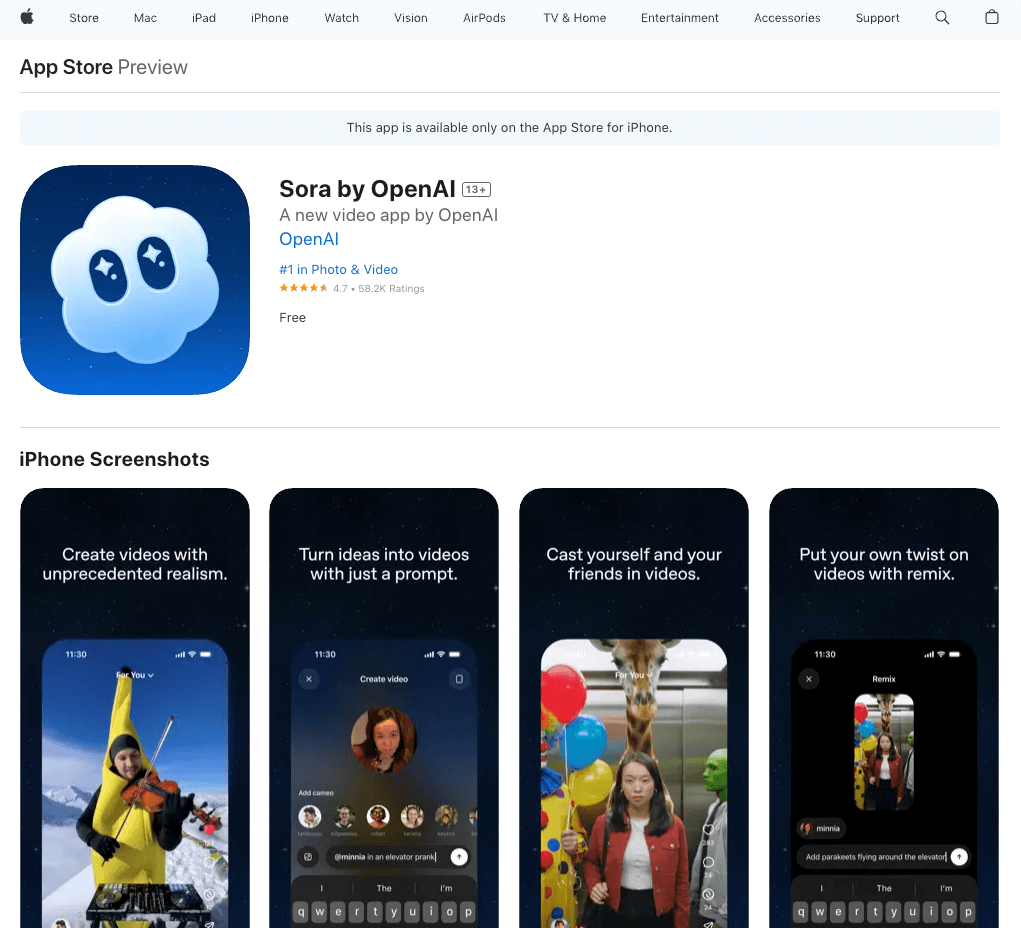
Sora 2 is not perfect, but it is available. Those who experiment and learn now will gain a decisive head start before the technology becomes available to everyone.
The question isn’t whether AI video generation will change your content strategy – it’s whether you’re ready to be one of the first to understand how to use it properly.
